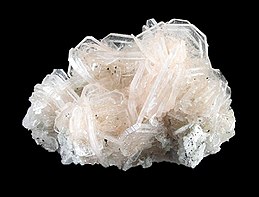The name apophyllite refers to a specific group of phyllosilicates, a class of minerals. Originally, the group name referred to a specific mineral,[4] but was redefined in 1978 to stand for a class of minerals of similar chemical makeup that comprise a solid solution series, and includes the members fluorapophyllite-(K), fluorapophyllite-(Na), hydroxyapophyllite-(K). The name apophyllite is derived from the Greek apophyllízo (ἀποφυλλίζω), meaning 'it flakes off', a reference to this class's tendency to flake apart when heated, due to water loss. Exfoliation of apophyllite is also possible by treating it with acids or simply by rubbing it. These minerals are typically found as secondary minerals in vesicles in basalt or other volcanic rocks. A recent change (2008) in the nomenclature system used for this group was approved by the International Mineralogical Association, removing the prefixes from the species names and using suffixes to designate the species.[5] A subsequent nomenclature change approved by the International Mineralogical Association in 2013 renamed the minerals to include both suffixes and prefixes, as shown above.[6]
| Apophyllite | |
|---|---|
 | |
| General | |
| Category | Phyllosilicate |
| Formula (repeating unit) | (K,Na)Ca4Si8O20(F,OH)·8H2O |
| IMA symbol | Apo[1] |
| Crystal system | Tetragonal |
| Space group | P4/mnc |
| Identification | |
| Color | Usually white, colorless; also blue, green, brown, yellow, pink, violet |
| Crystal habit | Prismatic, tabular, massive |
| Cleavage | Perfect on (001) |
| Fracture | Uneven |
| Mohs scale hardness | 4.5–5 |
| Luster | Vitreous; pearly |
| Streak | White |
| Diaphaneity | Transparent to translucent |
| Specific gravity | 2.3–2.4 |
| Refractive index | 1.536 |
| Birefringence | 0.000–0.003 |
| Pleochroism | Dichroic (colorless) |
| Other characteristics | |
| References | [2][3] |
Though relatively unfamiliar to the general public, apophyllites are fairly prevalent around the world, with specimens coming from some of the world's most well-known mineral localities. These localities include: Jalgaon, India; the Harz Mountains of Germany, Mont Saint-Hilaire in Canada, and Kongsberg, Norway, with other locations in Scotland, Ireland, Brazil, Japan, and throughout the United States.
Structure
editApophyllite has an unusual structure for a phyllosilicate. Whereas most phyllosilicates have a T layer (silica backbone) consisting of interlocked 6-fold rings of silica tetrahedra, with pseudohexagonal symmetry, the T layer in apophyllite consists of interlocked 4-fold and 8-fold rings of silica tetrahedra with true tetragonal symmetry.[7][8]
-
T layer (silica backbone layer) of apophyllite
-
Structure of apophyllite viewed in the {100} direction, parallel to layering
-
Unit cell of apophyllite
Species
edit- Fluorapophyllite-(K) (formerly fluorapophyllite, apophyllite-(KF)), KCa4Si8O20(F,OH)·8H2O – white, colorless, yellow, green, violet[9]
- Hydroxyapophyllite-(K) (formerly hydroxyapophyllite, apophyllite-(KOH)), KCa4Si8O20(OH,F)·8H2O – white, colorless[10]
- Fluorapophyllite-(Na) (formerly natroapophyllite, apophyllite-(NaF)), NaCa4Si8O20F·8H2O – brown, yellow, colorless[11]
- Fluorapophyllit-(Cs) (new) CsCa4(Si8O20)F·8H2O[12]
- Fluorapophyllit-(NH4) (new) NH4Ca4(Si8O20)F⋅8H2O[13]
-
Isolated Fluorapophyllite-(K) cluster on contrasting matrix
-
Hydroxyapophyllite
-
Fluorapophyllite-(Na)
See also
editReferences
edit- ^ Warr, L.N. (2021). "IMA–CNMNC approved mineral symbols". Mineralogical Magazine. 85 (3): 291–320. Bibcode:2021MinM...85..291W. doi:10.1180/mgm.2021.43. S2CID 235729616.
- ^ "Radioactive Gems: ClassicGems.net".
- ^ Apophyllite data on Webmineral
- ^ Spencer 1911.
- ^ Burke, E.A.J. (2008): Tidying up mineral names: an IMA-CNMNC scheme for suffixes, hyphens and diacritical marks. Mineral. Rec., 39, 131–135.[1]
- ^ Hatert, Frederic; Mills, Stuart J.; Pasero, Marco; Williams, Peter A. (2013). "CNMNC guidelines for the use of suffixes and prefixes in mineral nomenclature, and for the preservation of historical names" (PDF). European Journal of Mineralogy. 25 (1): 113–115. Bibcode:2013EJMin..25..113H. doi:10.1127/0935-1221/2013/0025-2267. hdl:2268/136406.
- ^ Klein, Cornelis; Hurlbut, Cornelius S. Jr. (1993). Manual of mineralogy: (after James D. Dana) (21st ed.). New York: Wiley. pp. 522–523. ISBN 047157452X.
- ^ Ståhl, Kenny (1 January 1993). "A neutron powder diffraction study of partially dehydrated fluorapophyllite, KCa4Si8O20F.6.9H2O". European Journal of Mineralogy. 5 (5): 845–850. Bibcode:1993EJMin...5..845S. doi:10.1127/ejm/5/5/0845.
- ^ Apophyllite-(KF) on Mindat
- ^ Apophyllite-(KOH) on Mindat
- ^ Apophyllite-(NaF) on Mindat
- ^
Atali A. Agakhanov, Leonid A. Pautov, Anatoly V. Kasatkin, Vladimir Yu. Karpenko, Elena Sokolova, Maxwell C. Day, Frank C. Hawthorne, Vyacheslav A. Muftakhov, Igor V. Pekov, Fernando Cámara, Sergey N. Britvin (2019), "Fluorapophyllite-(Cs), CsCa4(Si8O20)F(H2O)8, a new apophyllite-group mineral from the Darai-Pioz Massif, Tien-Shan, northern Tajikistan", The Canadian Mineralogist (in German), vol. 57, no. 6, pp. 965–971, Bibcode:2019CaMin..57..965A, doi:10.3749/canmin.1900038, hdl:2434/681913, S2CID 210259462
{{citation}}: CS1 maint: multiple names: authors list (link) - ^
Martin Števko, Jiří Sejkora, Jakub Plášil, Zdeněk Dolníček, Radek Škoda (2020), "Fluorapophyllite-(NH4), NH4Ca4(Si8O20)F⋅8H2O, a new member of the apophyllite group from the Vechec quarry, eastern Slovakia", Mineralogical Magazine (in German), vol. 84, no. 4, pp. 533–539, Bibcode:2020MinM...84..533S, doi:10.1180/mgm.2020.44, S2CID 225484232, retrieved 2021-04-11
{{citation}}: CS1 maint: multiple names: authors list (link), Format: PDF, KBytes: 623
- MinDat Listing
- Mineral Galleries
- Colville AA, Anderson CP, Black PM (1971). "Refinement of the crystal structure of apophyllite: I. X-ray diffraction and physical properties". American Mineralogist. 56: 1222–1233.
- Spencer, Leonard James (1911). . In Chisholm, Hugh (ed.). Encyclopædia Britannica. Vol. 2 (11th ed.). Cambridge University Press. p. 195. This describes the older definition as a specific mineral.